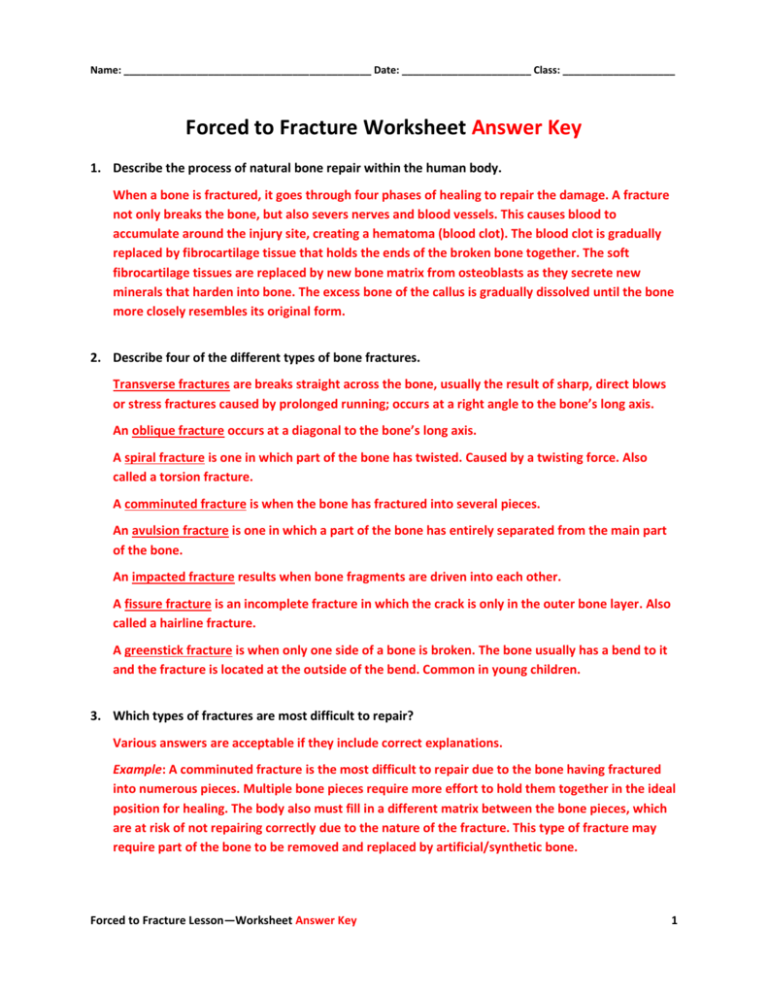Forced to Fracture Worksheet Answer Key
advertisement

Name: ____________________________________________ Date: _______________________ Class: ____________________ Forced to Fracture Worksheet Answer Key 1. Describe the process of natural bone repair within the human body. When a bone is fractured, it goes through four phases of healing to repair the damage. A fracture not only breaks the bone, but also severs nerves and blood vessels. This causes blood to accumulate around the injury site, creating a hematoma (blood clot). The blood clot is gradually replaced by fibrocartilage tissue that holds the ends of the broken bone together. The soft fibrocartilage tissues are replaced by new bone matrix from osteoblasts as they secrete new minerals that harden into bone. The excess bone of the callus is gradually dissolved until the bone more closely resembles its original form. 2. Describe four of the different types of bone fractures. Transverse fractures are breaks straight across the bone, usually the result of sharp, direct blows or stress fractures caused by prolonged running; occurs at a right angle to the bone’s long axis. An oblique fracture occurs at a diagonal to the bone’s long axis. A spiral fracture is one in which part of the bone has twisted. Caused by a twisting force. Also called a torsion fracture. A comminuted fracture is when the bone has fractured into several pieces. An avulsion fracture is one in which a part of the bone has entirely separated from the main part of the bone. An impacted fracture results when bone fragments are driven into each other. A fissure fracture is an incomplete fracture in which the crack is only in the outer bone layer. Also called a hairline fracture. A greenstick fracture is when only one side of a bone is broken. The bone usually has a bend to it and the fracture is located at the outside of the bend. Common in young children. 3. Which types of fractures are most difficult to repair? Various answers are acceptable if they include correct explanations. Example: A comminuted fracture is the most difficult to repair due to the bone having fractured into numerous pieces. Multiple bone pieces require more effort to hold them together in the ideal position for healing. The body also must fill in a different matrix between the bone pieces, which are at risk of not repairing correctly due to the nature of the fracture. This type of fracture may require part of the bone to be removed and replaced by artificial/synthetic bone. Forced to Fracture Lesson—Worksheet Answer Key 1 Name: ____________________________________________ Date: _______________________ Class: ____________________ 4. What factors might affect bone strength? The location of the fractured bone The density of the fractured bone The person’s age The person’s activity level Any vitamin and/or mineral deficiencies A calcium deficiency If the person suffers from scurvy (lack of vitamin C) 5. Research and describe at least three different types of surgical fracture repair. Internal fixation: A surgical procedure that sets broken bones back into place using implants such as screws and metal plates, pins, rods, wires and intramedullary devices such as the Kuntscher nail and interlocking nail. For example, a metal plate that is attached to both parts of the broken bone using screws or using a rod positioned along the inside of a long bone. External fixation: A surgical treatment to stabilize bone at a distance from the fracture. For example, drilling holes into the fractured bones in order to place screws or wires that are attached to a metal plate or rod that is outside of the body to secure the bones in position while they heal. Bone graft: A surgical procedure to replace missing bone in order to repair complicated bone fractures or fractures that fail to heal correctly. This involves removing part of the injured bone that is not healing correctly and replacing it with bone harvested from a cadaver or elsewhere on the same body, or using a synthetic bone designed to be reabsorbed and replaced by bone tissue as it heals. 6. What factors do engineers need to consider when designing new treatments? biocompatibility calcification strength weight material degradation chances of infection (invasiveness) cost Forced to Fracture Lesson—Worksheet Answer Key 2








